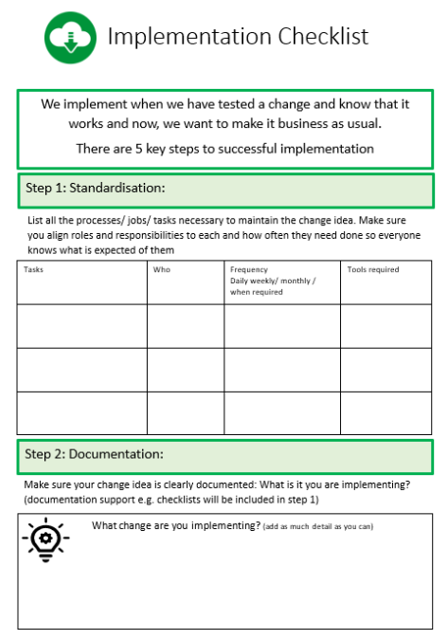Quality Improvement: Implementation Planning
About implementation planning
Implementation planning templates can support your team to consider the impact of change ideas, enablers and barriers to change, roles and responsibilities, and immediate next steps. This tool is designed to be used once you have tried and tested your change ideas in a variety of contexts and when you know that your change idea has resulted in an improvement to your system. The next step in the QI model is to make these improvements ‘business as usual’. The QI Zone provides an implementation checklist which can help plan implementation of improvement ideas. There is also a lessons learned log that will be a useful accompaniment to the implementation checklist. The checklist involves 5 steps that can help you implement and embed your change ideas:
- Standardisation: the process necessary to maintain change
- Documentation: clear documentation on the change you are implementing
- Measurement: how you will know if your change is an improvement
- Education: how are new ways of working being integrated into staff education for new and existing staff
- Resources: what resources are needed to implement your change idea

Supporting protocol – how you might use this tool:
When adapting and implementing a local mental health and substance use protocol, this tool can assist with:
- Imbedding your change ideas into business as usual
- Provide an outline of the staff and resources needed to make your change ideas future proof
- Provide evidence that your change idea can move beyond testing and implementation into spread.
Using the implementation checklist
While completion of the implementation checklist may not require workshops or QI based sessions, your team will need to meet or schedule a check ins to discuss the various elements of the checklist and how you will complete it. These could be in person or online. The resources section has further tools and guidance to support your planning.
What you need to do before
Gather the evidence you have gathered from your other discovery activities using the tools from strategic planning, service design and quality improvement to help set the focus for what you know of your systems, the people involved and how your engagement and improvement activities have made a difference.
What you will need to do during
- Use the date gathered from the above to support your completion of the implementation checklist. The data from your PDSA cycles will be especially useful. Be clear about the change that you are implementing, who is needed to support this and other documentation that you will need.
- Stipulate how you will use continuous data collection to ensure that you changes are making a difference over time. This will further support implementation and spread of your change idea.
- Be clear about how education and training will be used to support your changes and what staff need to be involved in these in staff induction through continuous professional development.
- Be clear about what additional resources will be needed for implementing your changes. Does this need senior management approval, additional funding, where will these resources come from etc.
Who should be involved
- Improvement team.
What to do after
- Use the documentation obtained throughout your improvement journey and share this within your systems and with senior leaders needed for sign off.
- Implement you changes into business as usual.
